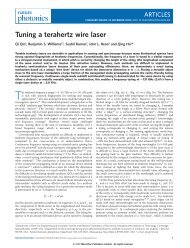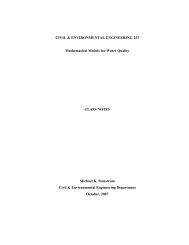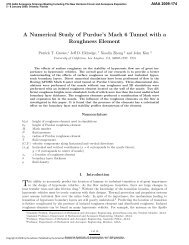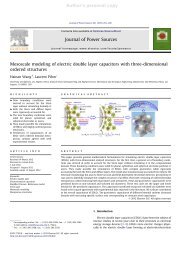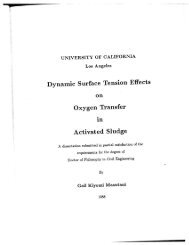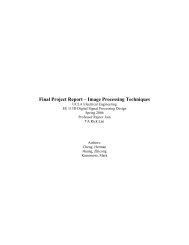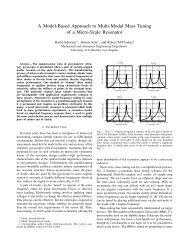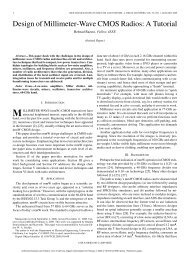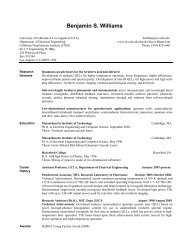Introduction to Modulation
Introduction to Modulation
Introduction to Modulation
Create successful ePaper yourself
Turn your PDF publications into a flip-book with our unique Google optimized e-Paper software.
EE215CB. RazaviWin. 10 HO #2<strong>Introduction</strong> <strong>to</strong> <strong>Modulation</strong>Baseband and Passband Signals• A passband signal can be expressed as:• <strong>Modulation</strong> converts a baseband signal <strong>to</strong> a passband signal (in mostcases):• <strong>Modulation</strong> Characteristics:- Signal quality in the presence of noise- Bandwidth efficiency- Power efficiencyAnalog <strong>Modulation</strong>Quality is quantified by SNR.• AM- Sensitive <strong>to</strong> noiseand nonlinearity- Requires linear PA.21
EE215CB. RazaviWin. 10 HO #2• PM and FM- Insensitive <strong>to</strong> nonlinearity- Can operate with nonlinear PA.- But occupies more BW.How <strong>to</strong> build a frequency modula<strong>to</strong>r?- Insensitive <strong>to</strong> nonlinearity- Can operate with nonlinear PA.- But occupies more BW.• Narrowband FM ApproximationIf the phase component is much less than 1 rad, then:For example, ifDigital <strong>Modulation</strong>Quality is quantified by bit error rate (BER). For voice, BER = 10 -3 .• Binary Shift Keying22
EE215CB. RazaviWin. 10 HO #2Simple BPSK Modula<strong>to</strong>r:• Quadrature <strong>Modulation</strong>The occupied bandwidth can be reduced by converting the data <strong>to</strong> twoslower streams and impressing each stream on the sine and cosine ofcarrier. For example, “quadrature phase shift keying” (QPSK) isperformed as follows:There are other variants of QPSK, e.g., DQPSK, π/4-QPSK, OQPSK.• Gaussian Minimum Shift KeyingFSK occupies <strong>to</strong>o much BW:Try “shaping” the baseband pulses:How <strong>to</strong> build aGMSK modula<strong>to</strong>r?23
EE215CB. RazaviWin. 10 HO #2Important Difference Between QPSK and GMSKQPSK also usually incorporates baseband pulse shaping:ShapedThus, shaped QPSK has a variable amplitude (envelope) and hencerequires a linear PA. GSMK, on the other hand, has a constantenvelope and can operate with nonlinear PAs.QPSK is used in CDMA cellphones and in 802.11b. GMSK is used inGSM cellphones and in Blue<strong>to</strong>oth (in which case it is called GFSK).Many other types of modulation are used: QAM, OOK, PAM,24
EE215CB. RazaviWin. 10 HO #2Multiple Access and Wireless StandardsMultiple Access Techniques• Time and Frequency Division DuplexingCellphones use FDD; most other systems use TDD.• Multiple Access- Frequency Division Multiple Access(FDMA) --- used in cellphones- Time Division Multiple Access(TDMA) --- used in cellphones andmost other systems- Code Division Multiple Access(CDMA) --- used in some cellphones25
EE215CB. RazaviWin. 10 HO #2• Near-Far Problem in CDMAThe basestation therefore needs <strong>to</strong> constantly moni<strong>to</strong>r and controleach mobile’s output power.Wireless StandardsA “standard” specifies all of the details of how a communicationsystem must operate, e.g., modulation, bit rate, duplexing, multipleaccess, frequency band, channel bandwidth.The standard also specifies exact performance tests.• GSMNow we have GPRS and EDGE. EDGE uses variable-envelopemodulation and requires a linear PA.• CDMA26
EE215CB. RazaviWin. 10 HO #2• Blue<strong>to</strong>oth- Frequency band = 2.400-2.480 GHz- Channel BW = 1 MHz- Bit rate = 1 Mb/s- TDD• 802.11a- Frequency band = 5.18-5.24 GHz, 5.26-5.32 GHz, 5.745-5.805 GHz- Channel BW = 20 MHz- Bit rate = 54 Mb/s- TDDAnd there are others …27



